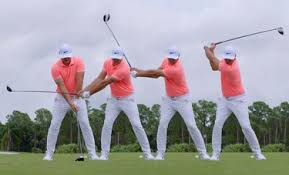How can you play better golf with LESS practice? The short answer is that practice can only help. If you are a Weekend Warriors and want to lower your scores, you better find a way to build consistency into your swing WITHOUT a lot of practice. Let’s face it, if your income is not based on being a scratch golfer like Rory McIlroy, you will never find the time to hone your perfect swing for every club. So what’s the best solution to improve your game?
I received a great article from Augusta Golf about the merits of practice. Ben Hogan was famous for practice. It’s the only way to become a master of any sport. Swing technique, strength, flexibility and mental fortitude all contribute to your successful game. He was right so if you want to lower your scores with limited practice , break the 4 areas of focus into a logical plan.

Simple techniques like keeping your head down as you impact your ball. The Star really caught Rory in the perfect picture of perfection.
Technique: Let’s face it, if you have a lousy swing and your technique is bad, you will never be able to consistently hit a golf ball with any of your clubs. You need to take golf lessons from a professional instructor. PGA instructors will set your game up in the right direction and can easily point out the problems with your swing. You don’t need to spend a lot of money to figure out how to improve your swing. Just understand your flaws and work on correcting your swing.
Ben Hogan’s clubs did not have the technology that exist in any 10 year old clubs that you may be using today so don’t expect that a new set of clubs will solve all of your problems. I recently saw a blog about “air swings” where you practice your swing without hitting a ball. It’s a good start but you really need to hit a ball at the driving range to focus on your swing path at the point of impact and see the result.
Strength and Flexibility:
Don’t ignore this important step in developing your full swing and stamina. If you don’t have the strength and flexibility of a teenager you need to put some effort into getting in reasonable shape or your will never be a good golfer. Golf is a sport that demands a lot from your body so choose exercises to build your upper body and core. You can’t expect perfection from your swing if you can’t develop a consistent rhythm and swing speed.
Mental Fortitude:
Tiger Woods is the perfect example of a person who was committed and focused to win at golf until his marriage scandal happened. He lost his “Mental Fortitude”. None of us will ever approach the skill and drive that Tiger once had but we can improve our game at the same time that we build our confidence in creating a more consistent game. Positive Mental Attitude goes a long way to create consistent hits. Rory McIlroy bounced back and it just paid off with $15 Million and most likely 10 times that in endorsement.
Reading Blogs like GOLFSTR Swing Tips will help you keep your mental focus on golf so that you can find the right formula for your game. Consistency, more power and confidence will lower your score. Practice with GOLFSTR+ for 6 swing solutions. Buy one today at www.golfstr.com





